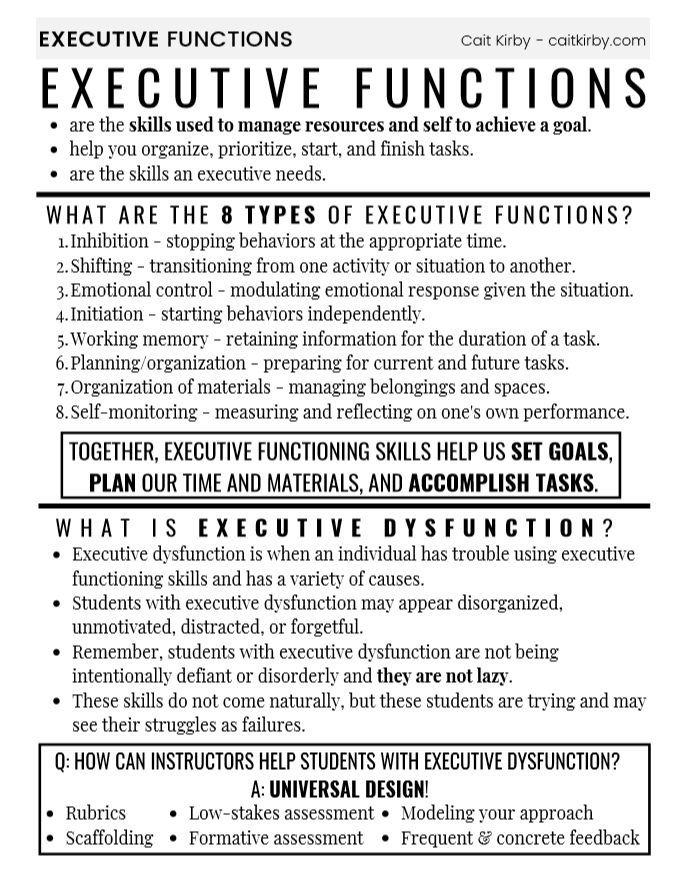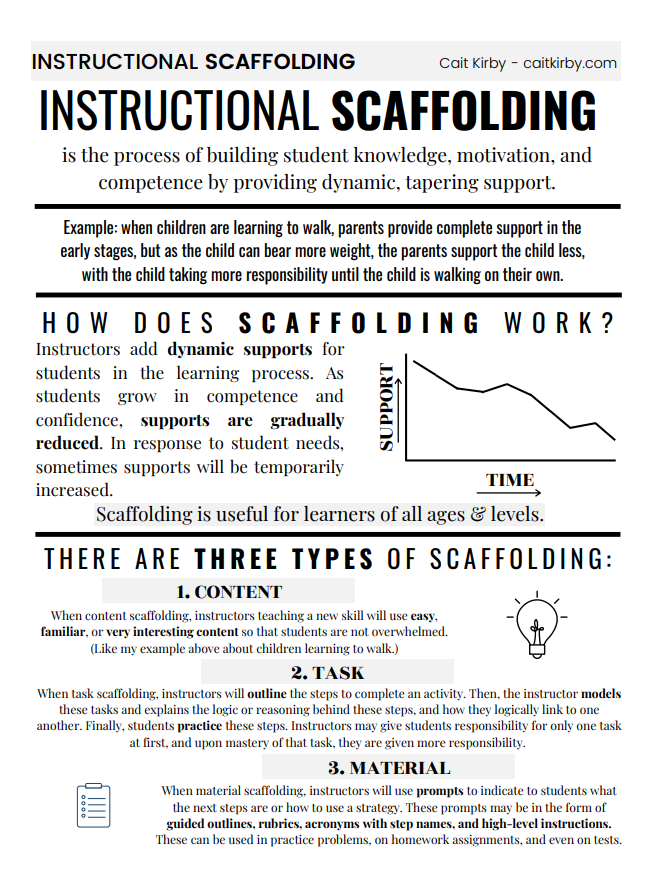2020-05-26 INCLUSION TEACHING
Author: Cait Kirby
Read time: 10 minutes
Executive functions and teaching problem solving: using instructional scaffolding in the framework of Universal Design
As I am preparing to teach a STEM-focused pedagogy course, I have been thinking about how we teach problem solving.
Further, I have been wondering what we assess when we ask students to solve a complex problem.
As always, my approach is access-centered and I wonder, how can we teach problem-solving in a way that does not simply assess students’ executive function?
For many, the concept of executive function is novel, so I will describe this concept here.
Executive functions are the skills that help us achieve goals and complete tasks – the skills a corporate executive uses.
 Photo of a one-sheet I made about executive functions available on my resources page.
There are eight executive functions:
Photo of a one-sheet I made about executive functions available on my resources page.
There are eight executive functions:
- Inhibition: stopping behaviors at the appropriate time.
- Shifting: transitioning from one activity or situation to another.
- Emotional control: modulating emotional response given the situation.
- Initiation: starting behaviors independently.
- Working memory: retaining information for the duration of a task.
- Planning/organization: preparing for current and future tasks.
- Organization of materials: managing belongings and spaces.
- Self-monitoring: measuring and reflecting on one's own performance.
You may recognize these skills – they are the same skills that scientists use when designing and executing experiments, they are the skills used on organic chemistry exams when students draw out a reaction, and they are the skills used when solving a mathematic proof. In fact, when I was preparing to teach a lesson about how to teach problem solving, my first reaction was to reference executive functions.
Here is an example: a student is given a problem in a biology course, to do a 3-point test cross to map the order of genes on a chromosome. First, a student needs to initiate an attempt to solve the problem, by identifying the type of problem it is. Next, a student needs to plan how they will approach the problem, and will need to organize the materials they need: paper, pen, identify parental genotypes, non-recombinant progeny, and double-crossover progeny. The student needs to shift from planning mode into analysis mode to reorder the genes and calculate the map distances. Next, the student must self-monitor and ask themselves if they have achieved the desired outcome. At this point, the student must regulate their emotions – if they have not achieved their goal, they must control their disappointment and try again, if they have achieved their goal they must contain their excitement, and maintain focus. At this point, the student must inhibit their focus toward this problem and move to the next problem or task. During this process, the student has held in their working memory the task at hand – mapping the genes – but also how much time is on the clock, how many other questions are on the exam, what time the dining hall is open until, and that they need to circle back to check their answer to question 2. Many of these skills are repeated throughout this exercise, I am simply demonstrating how each skill is used at least once.
Executive dysfunction is common in individuals with ADHD, learning disabilities, and trauma (both acute and chronic). Due to differences in the brain, individuals with these diagnoses and neurotypical individuals can struggle with executive functions. Importantly, these students should be encouraged to pursue problem-solving or science and math.
Instructors should take an approach to helping students with executive dysfunction that is rooted in Universal Design.
If you are unfamiliar with Universal Design, it is the concept that the world is currently built in an exclusionary way that requires individuals to ask for accommodations, and instead, we should create an environment that does not require anyone to ask for accommodations because it is designed for universal access, hence Universal Design.
The approach should be applied to all students, regardless of ability.
 Photo of a one-sheet I made about instructional scaffolding available on my resources page.
Instructors should ensure that they are adequately preparing students to problem-solve by using instructional scaffolding.
Like scaffolding used in construction work - the metal beams that provide temporary support until permanent walls are built – instructional scaffolding provides temporary support until students develop permanent knowledge support.
One way to scaffold is to provide an outline of the steps they will need to solve the problem. This outline of steps is supportive for all students and as students develop greater knowledge and comfort with the topic, they will rely on the outline less. Much like training wheels on a bicycle, as students become more knowledgeable and independent, scaffolding can be reduced.
Photo of a one-sheet I made about instructional scaffolding available on my resources page.
Instructors should ensure that they are adequately preparing students to problem-solve by using instructional scaffolding.
Like scaffolding used in construction work - the metal beams that provide temporary support until permanent walls are built – instructional scaffolding provides temporary support until students develop permanent knowledge support.
One way to scaffold is to provide an outline of the steps they will need to solve the problem. This outline of steps is supportive for all students and as students develop greater knowledge and comfort with the topic, they will rely on the outline less. Much like training wheels on a bicycle, as students become more knowledgeable and independent, scaffolding can be reduced.
For example, an outline of steps required for problem solving can be introduced at the beginning of the module that students can refer to while doing practice problems. As the semester progresses, quizzes may contain partial outlines. Finally, by the end of the semester, exams may only contain language that strongly suggests the first step. Importantly, I encourage instructors to include thorough instructions or abbreviated rubrics with all open-ended exam questions, which may also signal to students small clues about how to answer the question for full credit.
When creating an outline to teach students how to solve a problem, you might include the markers or keywords they should look for, the major steps, and some signal that they have reached the answer. For example, if you are teaching students how to dilute a solution to a specific concentration, your outline might look like this:
- the question – does it ask for you to dilute or make a solution, mixture, or buffer?
- Figure out your units – what units does it ask for? What units does it provide?
- Remember your formula – M1*V1=M2*V2. Which means, Molarity 1 times Volume equals Molarity 2 times Volume 2.
- Check your units - Make sure units are uniform across all volumes.
- Plug & chug – plug in your volumes and do the math.
- If you are given Molarity 1, Molarity 2, and Volume 2, solve for Volume 1 by multiplying Molarity 2 times Volume 2 and dividing that number by Molarity 1.
- Check your answer – is it in the right units (this is a signal you may be finished!)? Does it make logical sense? Is it in the ballpark?
If you are scaffolding, you may encourage students to use this outline when working on the homework assignments, and model its use in class. Then, on the first quiz, you may include steps 1, 4, and 6, reminding them how they know they are solving the correct problem, and giving two reminders about units. On the exam, you may only include one reminder: check your units. You may include that exam reminder as part of a rubric or set of instructions for your questions. For example, you might write “answers will receive full credit if all steps are shown (1 point), the correct numerical answer is identified (2 points), and the units are correct (2 points).” This question contains instructions, a rubric, and a reminder to check units, yet still tests the knowledge that students have gained throughout the module. Instructional scaffolding has supported them to reach this step.
I frequently present my experiments at lab meeting and a colleague often suggests another experiment that will complement my approach – a task that I did not identify on my own. I sometimes forget the next step in a Western blot and look to my protocol to make sure – that is what protocols are there for! What skills should we be teaching and testing our students on?
- identifying the problem we are trying to solve,
- determining where to go when we need help,
- finding the outlines and rubrics we need,
- persisting until we find the answer, and
- double-checking to confirm we are correct.
Providing outlines, instructions, and rubrics will facilitate your students’ development of these skills, while not excluding students with executive dysfunction.
If you think it is crucial that your students identify how to do this on their own without being given a walk-through, you are implicitly suggesting that students with executive dysfunction who need help should not be in your classroom.
I would guess that you do not think that rote memorization is what students should be learning from your class.
I would guess that you want students to learn application of knowledge, so providing signposts and outlines will help them with that application.
If you do not see the value in including these instructions, rubrics, and outlines, then you are essentially testing your students’ executive function skills and not testing what they have learned in your classroom.
Finally, I have spoken at great length here about how we can help students with executive dysfunction, but executive dysfunction is not restricted only to students.
I personally know faculty and administrators with executive dysfunction and ADHD.
It is important that we acknowledge that we have disabled colleagues who thrive with executive dysfunction – not in spite of it.
It is our responsibility to pave the way for future scientists with any range of ability and to support our disabled colleagues who are already in the academy.
One simple way we can do that is being supportive when executive functioning challenges arise and not equating executive function with knowledge.